White-backed Vulture Profile
There are few animals as unfairly misrepresented in popular culture as vultures. As carrion-feeders, they’re considered disease-ridden, dishonourable, and ugly.
Yet, they’re critical to the health of the ecosystem, particularly in the mammal populations who would otherwise be surrounded by sickness and parasites.
Unfortunately, these birds are in serious trouble as a result of this misrepresentation and of the same destructive agricultural practices that have wiped out so many species already.
The magnificent white-backed vulture is an Old World vulture species, and is the most common and widespread vulture species in Africa. However, like many vulture species it has experienced a rapid decline in population in recent years.
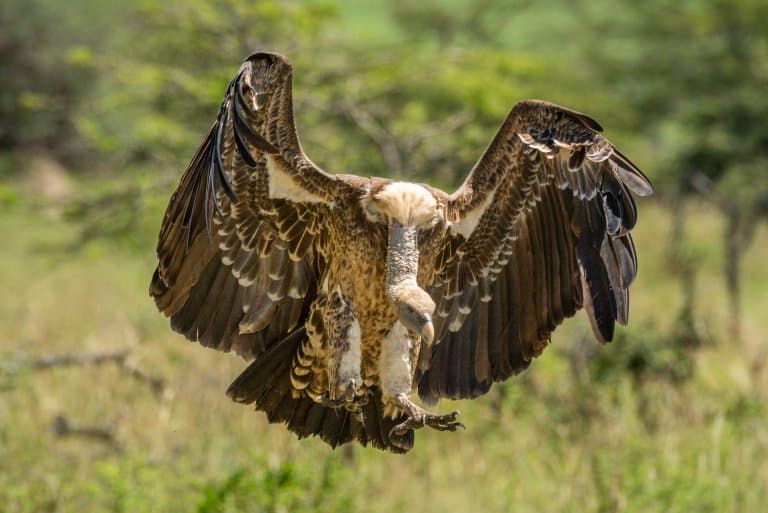
White-backed Vulture Facts Overview
| Habitat: | Forest, Savanna, Shrubland, Grassland, Desert |
| Location: | Central and Southern, Subsaharan Africa |
| Lifespan: | 19 years |
| Size: | 1 meter (40 inches) tall, 2m (7ft) wingspan |
| Weight: | Up to 7.2kg (16lb) |
| Colour: | Shades of grey, with lighter back and shoulders |
| Diet: | Carrion, dead mammals |
| Predators: | Humans |
| Top Speed: | Possibly 65 km/h (40mph) |
| No. of Species: | 1 |
| Conservation Status: | Critically Endangered |
White-backed vultures inhabit forests, savannas and grasslands across Africa, where they will build large nests of up to 1m in size high in trees.
While they are considered a medium-sized vulture species, they still boast a wingspan of over 2m (7 ft) and can weigh as much as 7.2kg (16lb).
They spend much of their time scavenging for food from carcasses of large grazing animals such as zebras, gazelles, or livestock.
Despite their role as vital ecosystem cleaners, white-backed vultures are highly vulnerable to human threats. Among the leading hazards are electrocution from power lines, hunting, and poisoning, the latter of which is widespread and devastating.
This is a species in dire need of help, and without which, multiple ecosystem services will be without their custodians.
Interesting White-backed Vulture Facts
1. They’re obligate scavengers
White-backed vultures are highly specialized obligate scavengers that feed primarily on the carcasses of large, grazing animals like warthogs, zebras, gazelles, and livestock.
These birds employ a “pulling feeding tactic” to consume soft tissues such as viscera, as their beaks are not well-suited for tearing through tough skin or bone.
They locate food by soaring at great heights and using their keen eyesight. Their presence is often indicative of a nearby carcass, attracting other scavengers to the feast.
They are social birds and will signal food discoveries to other vultures and feed in groups.

2. They are specialised for carrion
Because of their facial limitations, their food consists almost exclusively of muscle and viscera from large ungulates.
Interestingly, they don’t rely much on predator kills for their sustenance. Instead, the majority of animals they feed on have died from natural causes such as malnutrition, disease, or accidents. This creates less competition and provides a niche for the birds, as well as making their role as cleanup crew even more significant.
When hungry, these vultures can cover astonishing distances. Marked birds have been recovered more than 1,100 km from their initial ringing site. Regularly, they travel between their nesting sites and feeding areas, sometimes covering 240 km or more in a single journey. 1
3. They’re efficient!
Maxxing out at around 7kg, these are lightweights among African carnivores, so they have to be quick at what they do.
White-backed vultures are usually the first to spot a carcass, but they’re not the last. Their job is to get in and out before the larger scavengers like lions and hyenas arrive, and they’re very good at this.
It takes one bird roughly three minutes to get its pound of flesh, meaning that 100 African White-backed Vultures can strip a 100-pound carcass clean in that time.
Vultures have highly specialized digestive tracts that enable them to break down carrion efficiently.
Their sharp bills, barbed tongues, and the epithelium lining in their buccal cavity and oesophagus are adapted for the rapid swallowing of large chunks of food.
Vultures can hold up to 1,200 grams of food in their crops, about 20% of their body weight, which is sufficient to sustain them for 3–4 days.
Once ingested, the food meets the extremely low pH levels in the stomach, optimized for rapid chemical breakdown and the total destruction of pathogens. 2
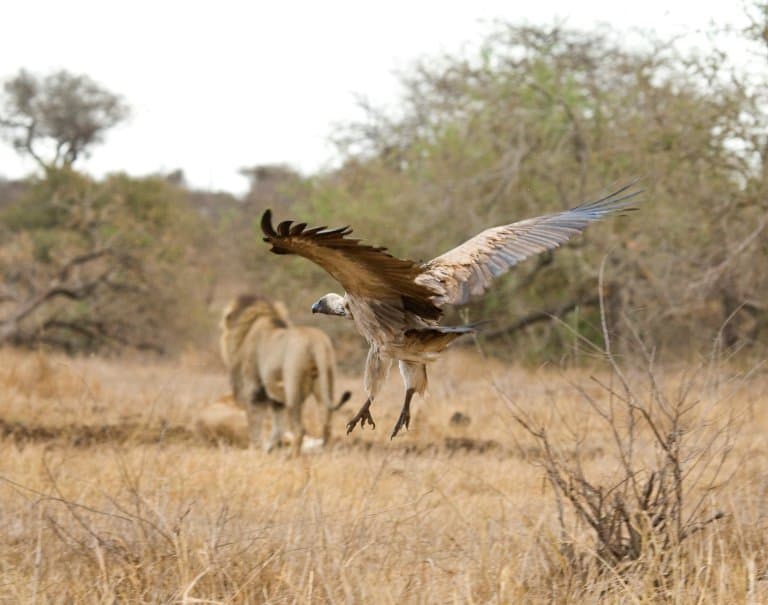
4. They’re so important
Studies have indicated that the normal bacterial flora in a vulture’s gut consists mainly of gram-negative bacilli of the family Enterobacteriaceae, familiar to us as E. coli. This is in line with what one would expect from carnivorous birds and is generally consistent with the gut flora of other East African birds of prey.
This tolerance to bacteria that would kill us is exactly how they manage to harbour and process the scary stuff that grows on sunbaked, rotting carcasses and prevent it from entering the mammalian population.
Essentially, what this means is that they are flying autoclaves, able to sanitise rotting flesh before pathogens get time to spread into the wider community
Despite this, like many other vulture species, they are one of the most persecuted animals across their range.
5. They’re hunted
Although they are primarily scavengers and not dangerous to humans or livestock, they are nonetheless targeted for various reasons that now endanger their survival.
The perception that griffon vultures are a threat to livestock also drives some people to hunt these important birds. Even though their main diet consists of carrion, and they are not predatory towards live animals, misunderstandings about their role can lead to conflicts with humans.
In some cultures, particularly in Southern and West Africa, these vultures are hunted due to traditional beliefs. This can be for “cultural” reasons such as the witchcraft of other superstitions, or for status as trophies. 3
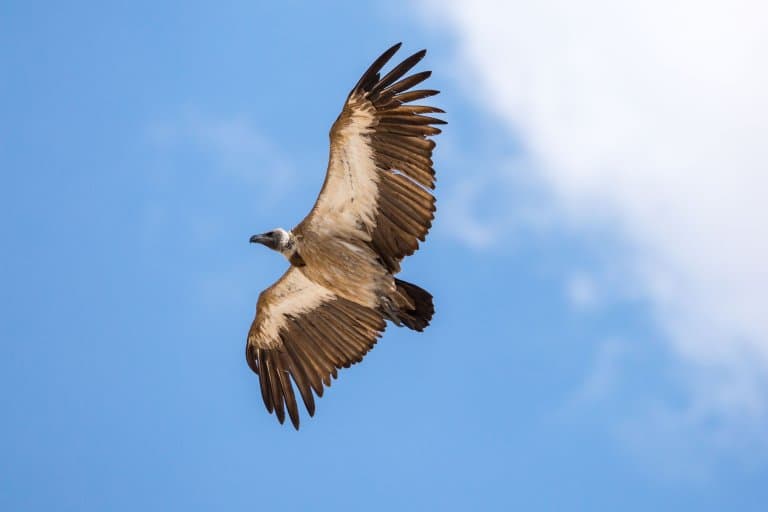
6. And poisoned
Perhaps more crucial to curb is the mass poisoning of birds from various chemical sources. All Griffon (Gyps) vultures face a critical and often lethal hazard in the form of poisoning, a danger that poses significant risks to their already vulnerable population.
This type of threat is especially insidious, as it typically goes undetected until it’s too late.
As scavengers specialized in consuming dead animals, these vultures are at particular risk of ingesting poison. Poisoned carrion can be the result of attempts to control predator populations, or simply an incidental by-product of livestock medication.
They’re also poisoned by lead shot from hunters, and persecuted deliberately by poachers, who believe that circling vultures give away their positions.
In a single recorded event, at least 144 White-backed Vultures were killed after feeding on an elephant carcass in Zimbabwe.
The rise in livestock medication has played one of the most significant roles in this species’ decline, as the anti-inflammatory diclofenac has proven to be a powerfully toxic chemical to vultures.
7. They’re running out of food
And the expansion of all of these factors means there’s little room for manoeuvre for the vultures.
Habitat conversion and the decline of wild ungulates have led to reduced availability of carrion.
Even increased livestock numbers haven’t helped, as improved animal husbandry practices limit the number of available carcasses, and those that die have a high chance of contaminating the birds anyway.
Human activities like wind energy development, logging, and natural gas exploration are also affecting their habitats, and they’re commonly electrocuted by new powerlines that are erected without marking for birds. 4
8. They’ve suffered a rapid reduction in number
The innumerable challenges faced by white-backed vultures have taken their toll.
From an estimated 270,000 individuals in 1992 to possibly less than a tenth of that number now, this species has rapidly declined. West Africa alone has seen declines exceeding 90%.
This is one of the fastest tragedies of any species in recent years, and the IUCN classification has dropped from Least Concern by the turn of the ‘90s, to Critically Endangered today.
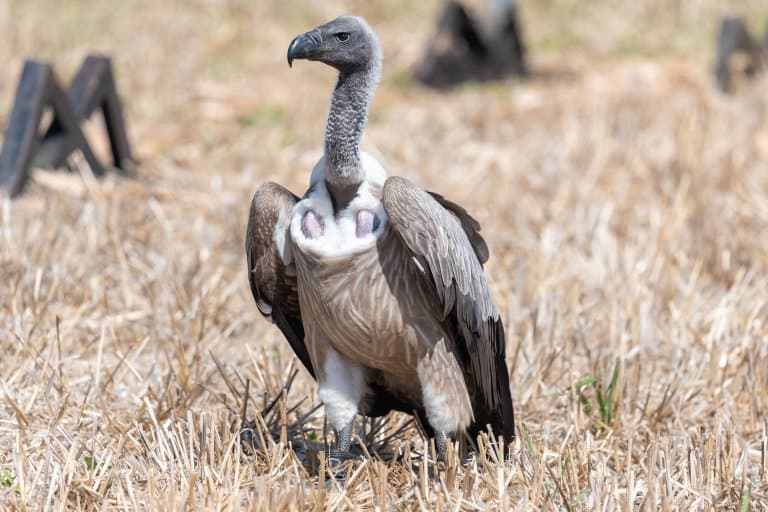
9. They’re born survivors
Perhaps the most critical piece of information for the conservation of this species is their high adult survival rates.
Despite the numerous threats they face, white-backed vultures have a high survival rate as mature birds. However, their juvenile survival rate is low. This means their species is particularly affected by the death of mature individuals, who are needed to protect their young.
Across all ages, this rate averages above 90%, showing that with a little protection, these birds can prove resilient against their threats. With this information, there are some programs in place and gaining traction.
10. Botswana conservation case study
Botswana serves as a refuge for vultures, owing to its extensive protected areas. However, the region still experiences poisoning events that have significantly impacted vulture populations.
The large scale of the landscape and low human density do offer some respite from anthropogenic influences, but more proactive measures are needed to preserve this critical species, especially considering the long-distance scavenging of the species. 5
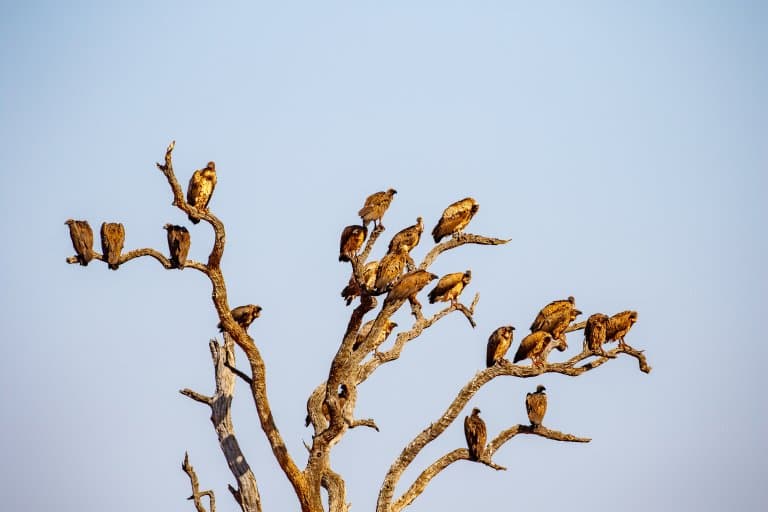
White-backed Vulture Fact-File Summary
Scientific Classification
| Kingdom: | Animalia |
| Phylum: | Chordata |
| Class: | Aves |
| Order: | Accipitriformes |
| Family: | Accipitridae |
| Genus: | Gyps |
| Species: | Gyps Africanus |
Fact Sources & References
- D. C. HOUSTONJ (1975), “THE DIGESTIVE TRACT OF THE WHITEBACK GRIFFON VULTURE AND ITS ROLE IN DISEASE TRANSMISSION AMONG WILD UNGULATES“, Sci Hub.
- “African White-backed Vulture”, The Peregrine Fund.
- Mark D. Anderson, “African White-backed Vulture Gyps africanus”, Sungura.
- “White-backed Vulture”, IUCN Red List.
- “White-backed Vulture (Gyps africanus)”, Species Conservation.
